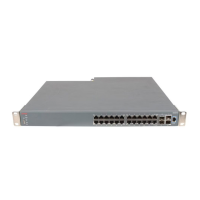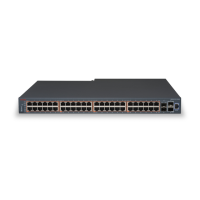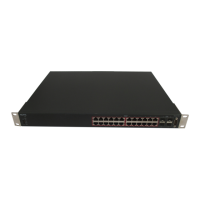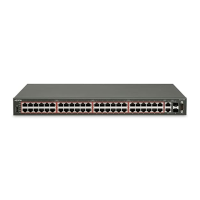Resetting the switch to default settings
Perform this procedure to reset the switch to the factory default settings with the ACLI.
1. Enter boot default.
2. Enter y to confirm the reset.
The switch restarts with factory default settings and attempts to read the ip.cfg file from an
installed USB drive within three minutes. The banner page appears while the switch retrieves
the ip.cfg file.
Important:
If you have a console connected to the switch / stack, then while the system retrieves the ip.cfg
file from the USB memory device, the Avaya banner page appears. If you use the serial console
while the system is restarting or within the first few minutes after booting, then the switch will not
load the IP.CFG file. If you want the switch to load the configuration using IP.CFG, Avaya
recommends not interact with the switch via the console port for a period of 3 minutes after
booting the switch or stack. This is necessary to give the switch sufficient time to load the
IP.CFG file and take appropriate actions. If the switch is also performing an automated update
of the software, then this period of time will be increased as the switch will need to perform an
automatic reboot during the IP.CFG process to load the designated software.
Checking the status of the download
Perform this procedure to check the status of the download three minutes after the Avaya banner
page appears.
1. Press CTRL and y keys together.
Two possible responses indicate a pass or fail status.
• Pass: The system opens the first page of menu.
• Fail: The system prompts you for an IP address.
You can confirm the successful download with the show ip command. If the USB ip.cfg file
download succeeded, all parameters read from the ip.cfg file show as present in the switch and
become part of the runtime configuration. If there is an error parsing the ip.cfg file, a log entry
provides an indication of the error encountered.
If you have disabled autosave, then save the configuration with the ACLI command, copy config
nvram. After the successful ip.cfg file download from the USB memory device, you can manage the
switch through Telnet and SNMP.
If you load any diagnostic or agent images with ip.cfg, the diagnostic or agent images need to be on
the same USB memory device. Restart the system after you download the ip.cfg files. To ensure
that diagnostic and agent image downloaded successfully, check in the system log or audit log. If
the operation is successful, restart the switch or stack to display the new diagnostic and agent
images.
If you download an ASCII file, you must enter the settings after the download. You do not need to
restart the switch or stack if you download an ASCII file.
Set IP parameters for the switch
August 2016 Installing Avaya ERS 4800 Series 33
Comments on this document? infodev@avaya.com

